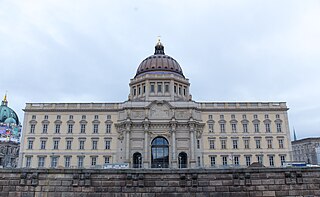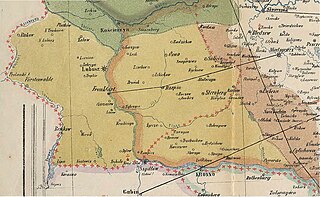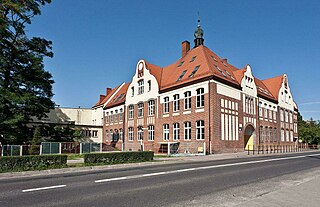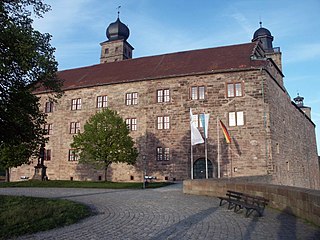History
The castle would have been built in the mid-12th century during German settlement – probably on the site of a Slavic marsh castle. Its builder is likely to have been Margrave Conrad I of Meißen. The castle is first mentioned in 1209.
Until 1382 the lords of Strehla were resident at the castle. They were succeeded by the lords of Bieberstein. In 1518 Ulrich of Bieberstein enfeoffed the castle to the Bishop of Lebus, Dietrich of Bülow. The castle was then expanded into an episcopal Residenz .
In 1538, Stefan Meiße, a friend and comrade-in-arms of Hans Kohlhase, was tortured to death at the castle. In 1555 the last Roman Catholic bishop of Lebus, John VIII of Horneburg (1551 – 1555), died here. In 1556 the castle and lordship went to Margrave John of Brandenburg-Küstrin. After his death the castle and estate finally ended up in the possession of the electors of Brandenburg.
In 1627, during the Thirty Years' War, the castle was badly damaged It was rebuilt as a small Renaissance residence, but suffered more damage, this time by fire, in 1775.
In 1910, the architect Johann Emil Schaudt bought the site and had it remodelled in a Romanesque historic style. Between 1934 and 1945, it was used as a Hitler Youth centre (a Jugendburg). From 1945 to 1978, municipal offices were housed in the castle.
In 1978 the site was destroyed by a major fire. Between 2000 and 2009 the building was gradually rebuilt. The re-inauguration of the castle took place at Pentecost in 2009 as part of the 800th anniversary celebrations of the town of Storkow.
Since May 2009 the visitor information centre for the Dahme-Heideseen Nature Park has been located at Storkow Castle. In addition to the permanent exhibition entitled "People and Nature - a Journey Through Time" about the nature and environment in the nature park, there are also changing exhibitions.

Neuruppin is a town in Brandenburg, Germany, the administrative seat of Ostprignitz-Ruppin district. It is the birthplace of the novelist Theodor Fontane (1819–1898) and therefore also referred to as Fontanestadt. A garrison town since 1688 and largely rebuilt in a Neoclassical style after a devastating fire in 1787, Neuruppin has the reputation of being "the most Prussian of all Prussian towns".

The Berlin Palace, formally the Royal Palace, on the Museum Island in the Mitte area of Berlin, was the main residence of the House of Hohenzollern from 1443 to 1918. Expanded by order of King Frederick I of Prussia according to plans by Andreas Schlüter from 1689 to 1713, it was thereafter considered a major work of Prussian Baroque architecture. The former royal palace was one of Berlin’s largest buildings and shaped the cityscape with its 60-meter-high (200 ft) dome.

Lubusz Land is a historical region and cultural landscape in Poland and Germany on both sides of the Oder river.

Sulęcin is a town in western Poland with 10,117 inhabitants (2019), the capital of Sulecin County, since 1999 in Lubusz Voivodeship.

Seelow is a German town, seat of the Märkisch-Oderland, a district of Brandenburg. As of 2013 its population was of 5,464.

Kulmbach is the capital of the district of Kulmbach in Bavaria in Germany. The town is famous for Plassenburg Castle, which houses the largest tin soldier museum in the world, and for its sausages, or Bratwürste.

Tangermünde is a historic town on the Elbe River in the district of Stendal, in the northeastern part of Saxony-Anhalt, Germany.

Marienberg Fortress is a prominent landmark on the left bank of the Main river in Würzburg, in the Franconia region of Bavaria, Germany. The mighty Fortress Marienberg is a symbol of Würzburg and served as a home of the local prince-bishops for nearly five centuries. It has been a fort since ancient times. Most of the current structures originally were built in Renaissance and Baroque styles between the 16th and 18th centuries. After Gustavus Adolphus of Sweden conquered the area in 1631 during the Thirty Years' War, the castle was reconstructed as a Baroque residence. After it ceased to serve as residence of the Bishops of Würzburg, the fortress saw repeated action in the wars of the late 18th and 19th centuries. Festung Marienberg was severely damaged by British bombs in March 1945 and only fully rebuilt in 1990. Today, it houses two museums.

Templin is a small town in the Uckermark district of Brandenburg, Germany. Though it has a population of only 17,127 (2006), in terms of area it is, with 377.01 km2, the second largest town in Brandenburg and the seventh largest town in Germany. The town is located in the south of the rural Uckermark region and its capital Prenzlau, north of the Schorfheide-Chorin Biosphere Reserve. The municipality comprises the villages of Ahrensdorf, Bebersee, Beutel, Densow, Gandenitz, Gollin, Gross Dölln, Gross Väter, Grunewald, Hammelspring, Herzfelde, Hindenburg, Klosterwalde, Petznick, Röddelin, Storkow and Vietmannsdorf.

Lebus is a historic town in the Märkisch-Oderland District of Brandenburg, Germany. It is the administrative seat of Amt Lebus. The town, located on the west bank of the Oder river at the border with Poland, was the centre of the historical region known as Lubusz Land, which provides the name for the present-day Polish Lubusz Voivodeship.

Fürstenwalde/Spree is the most populous town in the Oder-Spree District of Brandenburg, Germany.

Kostrzyn nad Odrą is a town in Gorzów County, Lubusz Voivodeship in western Poland, close to the border with Germany.

The Province of Brandenburg was a province of Prussia from 1815 to 1945. Brandenburg was established in 1815 from the Kingdom of Prussia's core territory, comprised the bulk of the historic Margraviate of Brandenburg and the Lower Lusatia region, and became part of the German Empire in 1871. From 1918, Brandenburg was a province of the Free State of Prussia until it was dissolved in 1945 after World War II, and replaced with reduced territory as the State of Brandenburg in East Germany, which was later dissolved in 1952. Following the reunification of Germany in 1990, Brandenburg was re-established as a federal state of Germany, becoming one of the new states.

Biesenthal is a town in the district of Barnim in Brandenburg, Germany. It is the administrative seat of the Amt Amt Biesenthal-Barnim.

Storkow (Mark) is a town in Oder-Spree district, in Brandenburg, Germany.

Górzyca is a village on the Oder river in Słubice County, Lubusz Voivodeship, in western Poland, close to the German border at Reitwein. It is the seat of the gmina called Gmina Górzyca. It lies approximately 18 kilometres (11 mi) north of Słubice and 49 km (30 mi) south-west of Gorzów Wielkopolski.

Tschanüff Castle is a ruined castle in the former municipality of Ramosch of the Canton of Graubünden in Switzerland. It is a Swiss heritage site of national significance.

St. Mary's Cathedral is a United Protestant church in the town of Fürstenwalde upon Spree, Brandenburg, Germany. It was formerly the cathedral of the Bishopric of Lebus, which was a Catholic diocese before the Protestant Reformation.

Schloss Kunreuth is situated on the northwestern edge of the eponymous village of Kunreuth which is part of the collective municipality of Gosberg in the county of Forchheim, in the province of Upper Franconia in the south German state of Bavaria.

Dietrich von Bülow was a German Bishop of Lebus-Fürstenwalde.































